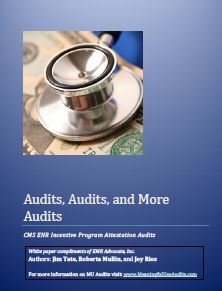 By Jim Tate (@jimtate), Roberta Mullin (@mssoftware), and Joy Rios (@askjoyrios)
By Jim Tate (@jimtate), Roberta Mullin (@mssoftware), and Joy Rios (@askjoyrios)
The HITECH Act of 2009 was created to stimulate the adoption of electronic health care technology by a combination of financial incentives and fee adjustments. Since that time over $30 billion has been received by providers who have attested to the “meaningful use of certified technology.” To make sure those incentives are justified, a vigorous audit program has been initiated that could occur up to six years after incentive attestation. A failed audit results in recoupment of 100% of received incentives for that specific “meaningful use” year.
How will you know if you are a target for an audit? CMS lays it out there as concisely as possible: “Any provider attesting to receive an EHR incentive payment for either the Medicare or Medicaid EHR Incentive Program potentially can be subject to an audit”.
Prepayment, post-payment, Medicare, Medicaid, dually-eligible, Eligible Professionals (EP), Eligible Hospitals (EH), national level, state level and yes, even Office of the Inspector General (OIG) oversight audits. How can you tell the players without a scorecard? Audits related to the CMS EHR Incentive programs have continued to change over time both in the nature and source of the audits. Some of the processes have matured into paths that are predictable while others continue to reflect confusion and inconsistently.
Given what is at stake, preparing for a pre or post-payment audit of a CMS EHR incentive should be considered part of the entire meaningful use process. And while attestations can be withdrawn, they cannot be withdrawn during an audit.
Here are five Best Practices for Audit Preparation and Response to consider from a list of 12 documented in a white paper created by the EMR Advocate team. You can download the full white paper.
- Assign and document who will lead the response team during an audit.
- Maintain all attestation related material in a secure location for a minimum of 6 years past attestation.
- During an audit have one point of contact to communicate with the auditor.
- Only provide what is specifically requested.
- Seek outside consulting expertise sooner rather than later.
At EMR Advocate, Inc. our involvement with audits based on the Meaningful Use program began in June 2011. Since that time our experience with a large number of EP and EH audits and appeals we have become aware of certain themes that have arisen and areas of potential risk have been identified. This white paper is a snap shot in time based on current direct knowledge.

